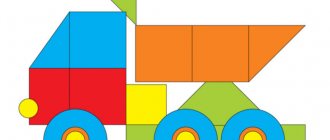Summary of the joint activity “The House Where I Live”
“Physical development” section “Physical education” - physical minute “Building a house”.
Types of children's activities:
game (playing out the building);
communicative (communication and interaction with adults and peers);
perception of fiction (reading a poem);
cognitive and research (object of the surrounding world “house”);
construction from building material (building a “house”);
motor (physical exercises);
basic household chores (after playing, put away building materials and toys).
Target:
“Creating conditions for the development of interest in constructive-model activities through a tabletop builder with subsequent playing out of buildings.”
Tasks:
Educational:
continue to lead to the analysis of the building ( two bricks stand close to each other on the left on narrow edges, two identical bricks stand on the right, two prisms on top, bricks in front and behind, placed with wide edges
);
help children use nouns with prepositions (on, for, in), adverbs (in front, behind, above, left, right);
continue to teach children to distinguish and name the essential parts of the house (walls, roof, windows, doors), materials and their properties (built of brick; wooden doors, solid walls, etc.)
Educational:
develop children's interest in constructive activities through a tabletop builder using small toys and crafts made from natural materials;
develop the ability to independently, without showing methods of action, construct buildings with free internal space (“house”).
Educational:
teach children to be polite (teach them to say hello, say goodbye, thank you for their help); interact and get along with each other in a short game together;
teach children to put away tabletop builders and toys after playing.
Methods and techniques:
practical - greetings accompanied by movements; physics lesson, construction of buildings from a tabletop builder;
visual – demonstration of illustrations;
verbal - questions that require statements (such as “How?”, etc.), questions that stimulate mental activity (such as “What do you think?”, etc.), conversation, explanation, reading a poem;
gaming - an imaginary situation, playing out buildings; d/ game “Whose house?”
Preliminary work:
looking at family photographs, illustrations on the topic “Houses are different”;
reading fiction (see the appendix to the program “From birth to school”);
plot-role-playing games: “Family”, “Daughters - Mothers”, “We are builders”;
d/games: “Who has what house?”, “Whose house?”;
Summary of the lesson “The House I Live In” for the senior group
Summary of the lesson “The house where I live” for the senior group
Target
: Summarize and systematize children’s knowledge about their home; clarify knowledge about your place of residence; Teach children to make a whole from parts.
Tasks:
Educational field "Social and communicative development"
- create conditions for the formation of kindness, friendliness, goodwill.
Educational field "Cognitive development"
- consolidate knowledge about parts of the house; — improve different types of attention, memory, logical thinking; - expand and enrich children’s knowledge about human housing;
Educational field "Speech development"
- practice the formation of complex adjectives; — replenish the active dictionary with antonyms; — improve children’s ability to solve riddles; — teach children to answer questions based on a plot picture; — develop free communication with peers and adults; - continue to expand and activate your vocabulary;
Progress of the lesson
Educator:
Guys, today we have gathered to play a little. But this game is not simple, we will learn by playing. Listen to the poem:
- They say there was such a case somewhere, people were driving home from work. As soon as we got there, suddenly - miracles: Everyone forgot their addresses. They are searching, worried, looking around, Residents are rushing about: “Where is our floor?” Everything is confused, everything is lost! Fortunately, this only happened in a fairy tale. I told you about this on purpose, Where do you live? Where was your house built? And are you familiar with the house?
Educator:
-What is this story about?
Children:
- About the house.
Educator:
Today we will talk about houses, what they are like, what they are made of, what material they can be built from.
Educator:
- There are different houses and they are called differently: wooden, brick, panel.
— How do you understand these names? (Children's answers.)
- Indeed, guys, you are right. Wooden houses are houses built from wood. - Brick - built from bricks - Panel - from blocks. — Houses can also be one-story or multi-story. How do you understand these names: one-story house, multi-story house? (Children's answers.) - That's right, a house consists of one floor, a multi-story house means it consists of two or more floors. -Please tell us what your house consists of? (roof, walls, window, doors, foundation). - What's in it? (It has rooms and furniture). - Now guess the riddles about which rooms we are talking about:
We brush our teeth, wash our hands, We take a bath in the evening, Every morning we are not bored, We just wash ourselves (Bathroom)
I always have a sweet dream at night In this room, And in the morning a ray of light sometimes wakes me up (Bedroom)
In this room, everyone is together. The family gathers. Sometimes to have fun. Sometimes to play. Everyone watches TV. Or reads a book (Living room, hall)
This room welcomes everyone who comes to our house (Hallway)
Educator:
Guys, you are great! All the riddles have been solved!
- Guys, how should you treat your home so that it has order and comfort? How do you help adults with this? (Children's answers).
- Well done! You will become wonderful helpers!
4. Physical school
There is a house in a clearing (The fingers of both hands make a “roof”).
Well, the path to the house is closed.
(Hands turned with palms to the chest, middle fingers touching, thumbs up - “gate”)
We open the gate (Palms turn out).
We invite you to this house.
("Roof").
Educator:
and now let’s play with you the game “Say it backwards”:
- My house is high, and my house is (low) - My house is light, and my house is (dark) - My house is one-story, and my house is (multi-story) - My house is big, and my house is (small) - My house is old, but my house (new) - My house is on the left of the road, and my house is on (the right of the road) - My house is on a wide street, and my house is on (narrow street)
Educator:
and now we will learn and analyze the meaning of the most famous proverbs and sayings about home
"My home is my castle"
A fortress is a strong and reliable structure that prevents enemies from entering the property. This is how a home is a support for a person, because at home they will always support, help and listen.
“It’s good to be away, but it’s better to be at home.” When you come to visit, they always set the table and bring out treats, that’s why they say that it’s good to be away. But when you try all the treats, talk with the owners of the house, dance, have fun, you get tired and are drawn to your home, that’s why they say that home is better
“Like the owner, so is the house.” It is often said that by the house and its condition you can determine what kind of owner it has. When a house is neat and tidy, it means that it has a good owner who looks after his house, cares for it and loves it. If a house is falling apart and there is no harmony in it, then this means that its owner is mismanaged, a slob.
Lesson summary:
— Guys, tell me, what kind of houses are there? (wooden, brick panels). - What kind of rooms are there at home? (kitchen, bedroom, living room). — What are the names of the houses where people live? (dwelling). — What sayings and proverbs do you remember?
Well done guys, you answered very well in today's lesson.
Theme of the week: “The house where I live”
Theme of the week: “The house where I live”
Familiarization with the outside world 1. The child must: *orientate himself in the house;
*know and name the location of its main parts; *be able to tell who lives on what floor; *know who builds houses and for whom, that building them is very difficult and takes a long time; *know what kind of houses there are. 2. “There are houses.” Search for the corresponding concept. For people - a residential building. For cars - garage. For dogs - a kennel, a booth. For horses - a stable. For pigs - a pigsty. For cows - a barn. For birds - a birdhouse, a nest. For chickens - a chicken coop, etc. 2.Describe your home. Constructing a monologue. For example. The house is multi-story, it has an entrance, stairs, elevator, doors, walls, steps, railings, windows, etc. The house has many apartments, rooms, a corridor, a kitchen, a bathroom, a toilet. The rooms have furniture, balconies, windows, etc. I live on the fifth floor. 3. Didactic game “Moving into an apartment.” Develop orientation on a plane, attention, memory, monologue speech; to develop interest in projective games. An adult, using the playful motive of getting an apartment and moving into it, invites the child to mark the apartment on the layout or floor plan, select from the total number of proposed silhouette pictures those that are needed to equip a particular room, conveniently place pieces of furniture, tell why these particular ones were chosen objects are already arranged. The child must play through several layout and interior options and choose the most convenient one. 4. Game "Fourth wheel". Develop the ability to classify attention and speech. Explain why the item is superfluous. Table, sofa, wardrobe, refrigerator. Wardrobe, bed, chair, TV. Bed, sofa, folding bed, chair. Chair, stool, bed. Wardrobe, bookcase, buffet, table. Computer desk, dining table, coffee table, sofa. Wooden chair, wardrobe, bench, glass table. Table, chair, cabinet, wall shelf. 5. Didactic game “What did the artist forget to draw?” Develop memory, spatial perception, analytical skills, imagination; cultivate respect for the construction profession. The pictures show houses that are uninhabitable because some parts are missing. The child must find these parts and complete them, explain why they are so necessary. Then name all the rooms in the house and tell about their purpose.
Speech development 1. Vocabulary development. Titles. Floor, entrance, balcony, loggias, panel, block, log, window, frame, window, stairs, railings, stairwell, doors, elevator, bell, roof, pipe, antenna, attic, basement, steps, castle, threshold, dugout , hut. Signs. Stone, wooden, white, gray, yellow, beautiful, one-story, two-story, multi-story, high - low, new - old, modern, light, comfortable, elegant, large, strong, durable, block, brick, panel, log, straw. Actions. Build, paint, open, close, knock, rise, call, go out, nail, lay, live. 2. Game “Say the opposite”. Search by antonym. Tall - low, distant - close, fast - slow, loud - quiet, wide - narrow, thick - thin, beautiful - scary, big - small, new - old, white - black. 3. Game “Name it affectionately.” Formation of nouns with diminutive suffixes. Window - window, little window. Frame - frame, frame. Room - little room, little room. Wall - wall, wall. Door - door, door. Balcony - balcony. A log is a log. Staircase - ladder. A call is a call. Roof – cover, cap. Threshold - threshold. 4. Game “One - many”. Formation of plural nouns in the nominative and genitive cases. Floor – floors – many floors. Frame - frames - many frames. Room - rooms - many rooms. Wall – walls – many walls. Floor – floors – many floors (multi-storey). Entrance – entrances – many entrances. Balcony – balconies – many balconies. Log - logs - logs. Window - windows - many windows. Window - windows - windows. Stairs - stairs - many stairs. Door - doors - doors. Call - calls - calls. Roof - roofs - many roofs. Pipe - pipes - a lot of pipes. Antenna - antennas - many antennas. Basement - basements - basements. Castle - castles - castles. 5. Game “We count.” Formation of plural nouns and adjectives in the nominative and genitive cases. One room – two rooms – five rooms. One large room – two large rooms – five large rooms. One house – two houses – five houses. One multi-storey building - two multi-storey buildings - five multi-storey buildings. One window – two windows – five windows, etc. 6. “If the house has two floors.” Formation of relative adjectives. If a house has one floor, we say that the house is one-story. If a house has many floors, which is difficult to count, we say that the house is multi-story. Two floors - a house... (two-story). Three floors - a house... (three-story). Five floors - a house... (five floors). Ten floors - a house... (ten-story). 7. Game “Mine, mine.” Agreement of nouns with personal pronouns. MY – loggia, frame, window, staircase, roof, pipe, antenna. MY – floor, house, entrance, balcony, elevator, bell, attic, basement, castle, threshold. 8. Game “Name which one?” Formation of relative adjectives. Thatched house - thatched; brick house - brick; house made of stone - stone; house made of wood - wooden.
Learning to read and write 1. Sound and letter “O”. 2.Repeat that the sound “O” is a vowel, indicated by a red chip. 3. Game “Repeat, don’t make a mistake.” Development of phonemic hearing and attention. MO – KO – TO. VO – HO – BUT. OKO - IT - OVO, etc. 4. Determine the place of the sound “O” in the word. Mark it on the strip with a chip. Words. Peas, window, autumn, carrots, lemon, tomato, Olya, oar, etc. 5.Give the concept of “sentence”. Learn to make sentences based on pictures. For example. The pictures show a girl and a carrot. Olya is a word. Carrot is also a word. Choose from the proposed words - actions the one in which the sound “O” is heard in the middle of the word: collects, waters, flight, digs. Flight is the word. *What does Olya do with carrots? *Olya flying carrots is a sentence. *What does the offer consist of? (A sentence consists of words.) *A sentence is indicated by a long strip with a corner on the left edge. This corner represents a capital letter. The sentence is written with a capital letter. There is a dot on the right edge of the strip. A period indicates that the sentence has ended. *How many words are there in a sentence? (Three words.) *Name the first word. (Olya.) Olya is the name of a girl. We write names with capital letters. *Under the strip indicating the sentence there is a strip indicating the first word (Olya). *Second word? (Flight.) *Third word? (Carrots.) *Each word is laid out in separate strips, spaces are left between the strips: the words in the sentence are written separately. *How is a sentence different from a word? A sentence tells us something, tells us something. Conclusion. The first word in a sentence is written with a capital letter. Words in a sentence are written separately. At the end of the sentence there is a period. 6. “How many times can you sing a word?” Working on word structure. a) monosyllabic words: house, floor – 1 time; b) two-syllable words: frame, threshold, lock, panel, floor - 2 times; c) three-syllable words: corridor, room, ceiling, window, staircase, railing, antenna, steps - 3 times.
FEMP 1. Consolidate knowledge about the properties of objects. 2. Learn to find signs of similarities and differences. 3. Learn to combine objects into groups based on common characteristics. 4. Game exercise “Leopold the Cat’s Birthday.” Exercise; Arrange flowers in vases as directed by an adult. Description. On the table are flat pictures depicting vases and flowers. Directions: name the flowers shown in the pictures; put a bell on the first vase, a rose on the second, a chamomile on the third, a poppy on the fourth, and a cornflower on the fifth. Name the flower that lies on the vase located behind the vase with a rose, name the flower that lies on the vase to the left of the vase with a rose, name the flower that lies on the vase located to the right of the vase with poppies. Place a vase with a rose ON the table, place a vase with poppies UNDER the vase with a bell, etc. 5.Introduce children to the concept of table, row, column. 6. Learn to classify objects (toys, animals, vegetables). For example. From a number of items, select all the toys (vegetables, all animals).



